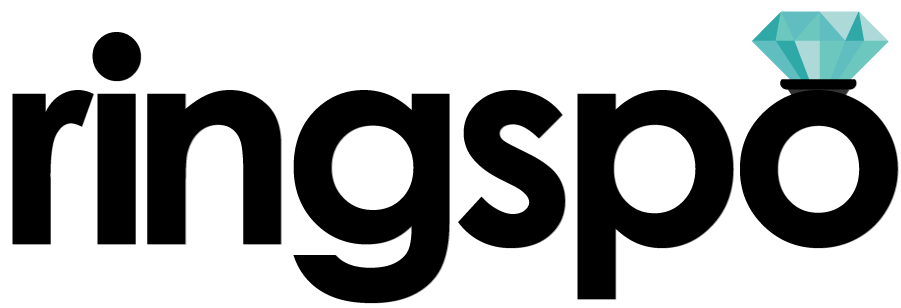Diamond stud earrings
How to get the best diamond stud earrings for you
Ringspo is reader supported
Ringspo is reader-supported, which means we may receive a commission if you click a link to a retailer & subsequently make a purchase.
We feature links to several retailers to help readers find the one that is the best fit for them. Find out more about how Ringspo works here.
Diamond studs are incredibly versatile as they seamlessly transition from an every-day staple to a special occasion showstopper.
They can also make the perfect gift – special enough to mark any occasion or anniversary..
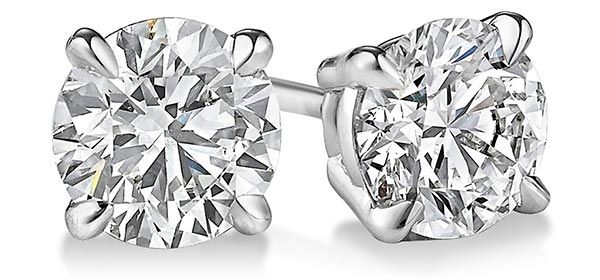
While the style possibilities for diamond stud earrings are practically endless, it can be challenging to know exactly which shape, level of quality and setting will suit you or a loved one best.
This guide to buying diamond stud earrings will reveal all of the ins-and-outs of finding the right diamond stud earrings for you.
We’ll break it down into four easy sections:
- Decide on your budget
- Decide on a metal
- Decide your style
- Find your diamonds
1. Decide your budget
You can spend anywhere from $200 to $40,000+ on diamond stud earrings.

But how much should you spend?
The answer to this question is a personal choice that reflects your preferences and priorities.
Something to know though, is the big difference that your choices will make on the value you get.
The big factors here is the the quality of the diamonds that you choose. They will make a huge difference to how far your budget goes.
Take, for example, a budget of $4,000 for some diamond stud earrings. That may be different to your budget, but it’s a useful one for this example.
A $4,000 budget could stretch to 2 x 3/4 carat diamonds, for a total carat weight of 1.5 carats, when paired with a 14k white gold settings.

Or, if a platinum setting is combined with two top quality diamonds, the total carat weight that a $4,000 budget can stretch to is just 0.92 carats:
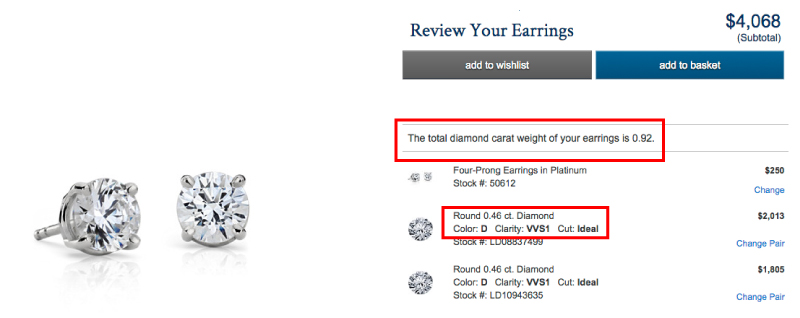
The bottom line is that by being smart with your choices, you can make your budget go much further.
Choosing diamonds that have been given top grades for color, cut and clarity will mean that you will have to compromise on carat ie. size.
It’s important that before you begin shopping around, figure out exactly how much you’re willing to spend and stick to it.
Such forethought will keep you from getting swept up in all of the sparkle.
2. Choose your metal
Diamond stud earrings are typically:
- white gold (either 14 karat or 18 karat)
- yellow gold (usually 18 karat)
- platinum

Which color should you choose?
Yellow gold looks particularly flattering on darker skin tones, while white gold and platinum pair well with lighter skin tones.
If you’re buying a gift and aren’t sure what color to choose, then a good rule of thumb is to look at the majority of the jewelry that the recipient wears.
If it’s yellow gold, then go with that, if it’s white in color then either white gold or platinum would be the best choice.
Platinum vs. white gold for diamond stud earrings
The major advantage that platinum has is that it is hypo-allergenic ie. it won’t irritate sensitive skin, like the nickel that is used in white gold can sometimes do.
The disadvantage of platinum over white gold is that it is denser and heavier. For earrings, lighter weight may be more comfortable for the wearer.
Platinum vs. white gold cost
Due to the small amount of precious metal used in earrings, there’s not a huge amount of difference in the price of the settings themselves:

One thing to know is that platinum earrings are often paired with higher quality and therefore more expensive diamonds in pre-set stud earrings.
These pre-set 14k white gold stud earrings are paired with diamonds which have been graded I for colour and I1 for clarity:

While these pre-set platinum stud earrings have been pre-paired with higher graded H color and VS2 clarity diamonds.

3. Choose your style
There are three main things to think about when choosing the style of your diamond stud earrings
- Whether you want to ‘build your own’ or buy pre-set
- The style of setting itself
- The style of ‘back’, which holds the earrings in place.
We’ll look at each of these in turn:
1. Pre-Set vs. ‘make your own’ diamond stud earrings:
When it comes to diamond stud earrings you have two clear choices, either purchasing a pair of diamonds that have been pre-matched and set for you, or creating your own unique pair by hand-selecting two loose stones and a setting yourself.
Pre-set diamond stud earrings:
Pre-set diamond studs have already been matched and mounted and the piece of jewelry is ready to be purchased and brought home.
The Pros of pre-set diamond stud earrings:
- Preset jewelry offers an unmatched level of convenience and takes out all of the guesswork. They’re just easier to buy.
- Pre-set diamond stud earrings are also less expensive.
- Most pre-set diamond stud earrings don’t come with a certification as the exact clarity and color doesn’t matter as much on a diamond earring as is does a diamond ring. The certification cost when hand-selecting stones alone would add approximately 35-40% to the cost of the pair.
The Cons of pre-set diamond stud earrings:
Most jewelers don’t provide certification for pre-set pairs of diamond stud earrings, and if certification is important to you then pre-set earrings may not be the best option for you.
If you don’t receive a certification with your earrings, you are trusting the retailer to supply diamonds of the size and quality that they tell you they are, without any independent verification.
Understandably, this makes many buyers of diamonds nervous
Some companies may intentionally mislabel and misrepresent the diamond quality used in their pre-set pairs, and it’s very difficult to tell if this is happening. If you aren’t careful, it’s easy to get ripped off. Click here to check out my trusted, recommended retailers.
Build-Your-Own diamond stud earrings:
Very self explanatory, with this method of diamond stud earrings selection you choose and buy two specific diamonds and have them put into a setting of your choice.
The Pros of build-your-own diamond stud earrings:
When you select your own diamonds you have full quality control, and you know exactly what you are getting.
You can save money by choosing diamonds that are a few points below the ‘magic sizes’ of .50 carat, .75 carat, 1 carat, etc.
Some jewelers will have already done the hard work for you by selecting ‘matched pairs’, of two diamonds that complement each other for you.
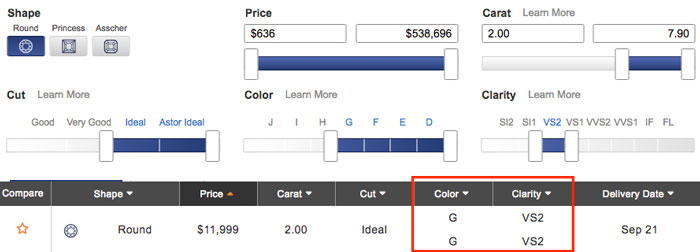
2. Types of diamond stud earrings
While there are others, these are the main types of stud earring style that you will find at most retailers:
Martini diamond stud earrings:
The martini setting is simple but classic, with the shape of the basket echoing the glass-shape of James Bond’s favourite tipple.
This is a simple and lightweight setting style that allows the diamond studs to fit the most snugly against the ear out of all styles.

Basket diamond stud earrings:
Basket style diamond studs are timeless, and arguably the most popular. This is the style that immediately springs to mind when someone imagines diamond studs.
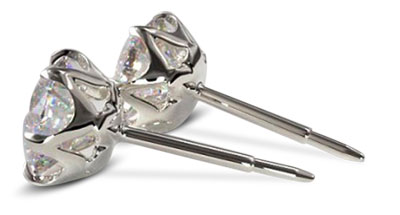
Bezel diamond stud earrings:
The defining feature of bezel set diamond stud earring s is a metal frame that surrounds the edge of the diamond, securely holding it in place.

This setting is very protective and great for those who lead an active lifestyle, or are a bit rough on their jewelry. Bezel settings do tend to be a bit more expensive due to the skill necessary to set them correctly.

Which stud earrings setting is right for you?
It’s important to always keep in mind that even the most dazzling diamonds will look floppy and dull if set into a poorly constructed setting.
The key to the best pair of diamond stud earrings is craftsmanship and balance.
Smaller carat sizes will really pop forward when set in a basket setting, but for larger carats a martini setting is recommended to ensure that the diamonds don’t droop, but instead sit flush against the ears.
Diamond stud earrings backs
Although seldom seen, most women have a personal preference when it comes to the feel and security of earring backs.
Friction back diamond stud earrings
Friction backs are the most common and the simplest choice.
They consist of a flat plate of metal with a hole, which the earring post then slides into, pressing the earring against the ear.

Friction backs are very easy to pop on and off, come in a variety of sizes, and are the most affordable choice. However they can have a tendency to easily slide off, and they tend to lose their grip through repeated use. Eventually, friction backs will need to be replaced.
Screw back diamond stud earrings
Screwback is the most secure option for diamond stud earring backs. They consist of a threaded post and a nut that is spun onto the post and up to the back of the ear.

Screwback earrings cannot be pulled off, they must be fully unscrewed.
I recommend getting screwbacks on diamond earrings that are 1 carat or over, as the added cost is worth it to ensure that your diamonds are safe and snug, and not going anywhere.
Keep in mind that screwbacks are more time consuming, and must be threaded carefully to avoid stripping the threads which would require the posts having to be replaced.
4. Select your diamonds
This may not technically be the fourth step in your journey to choose your diamond stud earrings.
You may have a good idea of the shape of stones that you want to include. However, I wanted to list out the common diamond shapes that are used in stud earrings and the reasons why each might be chosen.
Round brilliant cut stud diamond earrings
It’s no surprise the king of engagement rings is also dominates when it comes to diamond stud earrings.

Due to its symmetrical shape the round brilliant captures the light spectacularly, providing a big return on sparkle and brilliance. They also tend to feature fewer flaws, and are less likely to get caught on clothing than their sharp-cornered counterparts.
Due to their rampant popularity loose round brilliant diamonds are readily available, and can easily fit anyone’s budget.
Princess Cut diamond stud earrings:

Second in popularity only to the round brilliant, princess cut diamond studs look elegant but modern.
Their brilliant cut means that their sparkle is second only to the brilliance found in a round brilliant. But, when compared carat for carat, princess diamonds are typically more affordable than round brilliant diamonds.
Other diamond shapes for stud earrings
While round brilliant and princess are definitely the top cuts for diamond stud earrings, asscher, marquise, emerald, and pear, are all also available, albeit a lot less common.

Due to their distinctive shapes it is very obvious when these fancy cuts are not matched properly and any little difference in proportion will show through. This makes it very difficult to find two diamonds that would make a suitable pair of diamond stud earrings.
It might benefit you to consider face shape when picking out a pair of diamond stud earrings.
Broader face shapes are complemented by elongated shapes like the emerald cut, pear cut, and marquise cut. These shapes lend an impression of length with their elegant proportions. More angular face shapes are flattered by symmetrical shapes like the brilliant round cut, princess cut, and the asscher cut.
Diamond stud earrings color
Diamond color is less important for a pair of stud earrings than an engagement ring. The diamonds in stud earrings are not going top be examined closely
As a reminder, diamond color is graded from D – Z:

D-E-F: ‘Colorless’ diamonds for stud earrings
The rarest and most expensive colors, apart from ‘fancy’ colors (more on those later), only around 1% of stones will be graded D or E. Although they are rare, most stores and websites will have a selection of colorless D or E graded stones.
All diamonds in the ‘colorless’ range will look completely white to anyone who isn’t a gemologist, even when examined extremely closely.
In fact, even a trained gemologist with years of experience examining diamonds under bright jewelers’ lights may have trouble distinguishing between and D and an E graded stone.
Stones graded F will show a tiny hint of color to a gemologist, but to the average person they would still appear absolutely colorless, even when examined at close range.
For diamond stud earrings, which are likely to be viewed from a distance, choosing a ‘colorless’ diamond means that you will be paying extra for quality that will not be able to be seen.
G-H-I: ‘Near colorless’ diamonds for stud earrings
Although known as ‘near colorless’, the difference between these stones and the colorless diamonds is very slight, especially when they are mounted into jewelry.
However, near colorless stones they do offer significantly more value that the colorless, so if you are looking for a high quality stone then the Near Colorless diamonds are a good compromise between excellent color and budget.
Beyond the individual preference for a whiter diamond, the color of a stone does not affect its brightness or sparkle.
Most experts agree that a G-I color grade appears colorless when mounted, so spending more for D-F color diamonds really isn’t necessary.
Diamond stud earrings clarity
Diamond clarity is a measure of how many inclusions a diamond has in it. It’s measured on the following scale:

The clarity requirements for diamond stud earrings can be significantly relaxed when compared to diamonds destined for engagement rings.
This is primarily due to the fact that the distance at which they are viewed is a lot farther than the distance at which someone eyes a sparkly new engagement ring.
Many of the diamonds that aren’t considered eye-clean for engagement rings are just that for diamond studs.
Small inclusions and even some external flaws will simply not be visible on an earring. There are incredible savings to be had by sticking around the VS2-SI2 ranges. Any grade SI2 and above has inclusions that are eye-clean, and therefore not visible to the naked eye.
On occasion an I1 grade can be perfectly acceptable and an excellent value, as long as its inclusions are on the outer edge, or easily concealed beneath a prong.
Diamond stud earrings carat weight
The first thing to when shopping for a pair of diamond stud earrings is that the ‘total carat weight’ listed by most retailers is the combined carat weight for the two studs combined, not individually.
As on average the viewing distance for earrings is much further away compared to engagement rings, size is usually the first thing that people notice. So it makes sense for you to prioritize carat weight when shopping for a pair of diamond stud earrings.
As clarity and color can be sacrificed slightly compared to when buying a diamond for an engagement ring, more budget can be made available for carat weight.

Diamond stud earrings certification
Certification is the process of assessing and grading a diamond against predetermined characteristics – the 4Cs of cut, color clarity and carat. Basically putting them through the NFL Scouting combine to see how they measure up.
This process is conducted by independent labs who then issue a ‘grading report’ detailing the 4Cs, which is then used by retailers to work out the price of a stone.

As we’ve covered, many jewelers don’t provide grading certificates for pre-set pairs of diamond studs.
However, if you are creating your own pair of stud earrings and starting with loose diamonds, you should definitely seek out a Gemological Institute of America (GIA) or American Gem Society (AGS) certificate to ensure that you are really getting what you’re paying for.
Unless it is very important to you for personal reasons pursuing certification for diamond stud earrings less than 1 carat really isn’t necessary. Due to each stud’s smaller size and relative low cost it just doesn’t make sense to grade them, and adds a further expense.
Find your diamond stud earrings
I’ve listed some examples of diamond studs below, but each retailer will also have many other options for you to choose from. If you see a pair that you are interested in, click through to find out more.
0.25 Carat Weight Diamond Stud Earrings:
Cost
The average cost for round brilliant 0.25 diamond stud earrings is approximately $290, and the average cost for princess cut diamond stud earrings is $300.
Examples
This pair of 0.25 carat diamond stud earrings is round brilliant cut, and basket set in 14kt white gold. Available for a very budget friendly price of $225, click here to find out more about these Round Four-Prong Basket Diamond Stud Earrings from my recommended retailer Ritani.
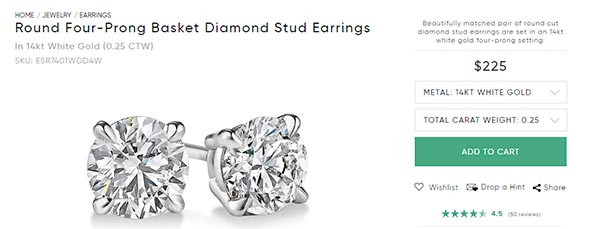
Like the pair of earrings above, this pair of diamond stud earrings is 0.25 carat and basket set in 14kt white gold. They feature princess cut matched diamonds, for the low price of $245.
Click here to find out more about these Princess Four-Prong Basket Diamond Stud Earrings available at my recommended retailer Ritani.

My overall recommended retailer for diamond stud earrings in the 0.25 carat range is Ritani, due to their excellent selection of both diamonds and settings, and the affordability of their pre-set pieces.
0.5 Carat Weight Diamond Stud Earrings:
Cost
The average cost for round brilliant 0.5 diamond stud earrings is approximately $1,000.
Examples
This pair of 0.5 carat diamond stud earrings is round brilliant cut, and basket set in platinum, so as to provide a basis of comparison when it comes to the differences in metal price.

Available for about double the price of 14kt gold, click here to find out more about these Diamond Earrings in Platinum from my recommended retailer Blue Nile.
This pair of 0.5 carat diamond earrings is princess cut, and set in the standard basket setting and 14k white gold. Available for a moderate $540, click here to find out more about these Princess-Cut Diamond Stud Earrings from my recommended retailer Blue Nile.

My overall recommended retailer for diamond stud earrings in the 0.5 carat range is Blue Nile, due to their unparallel selection of loose stones, and their general affordability.
0.75 Carat Diamond Stud Earrings:
Cost
The average cost for round brilliant 0.75 diamond stud earrings is approximately $2300, although this will depend on the shape and quality of the diamonds used.
Examples
This pair of 0.75 carat diamond stud earrings is round brilliant cut, and martini set in 18kt white gold. Available for $2,320, click here to find out more about these 18k White Gold Three Prong Martini Round Brilliant Diamond Earrings from my recommended retailer James Allen.
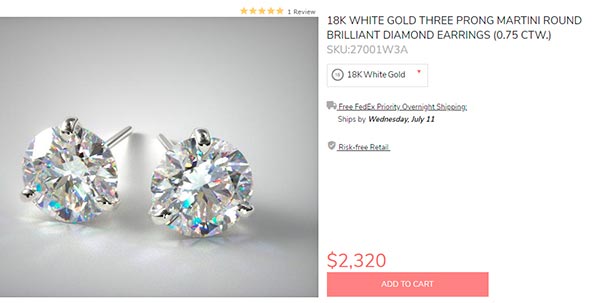
This pair of princess cut diamond stud earrings are a little bit above 0.75 carats, but provide an excellent value for just $30 more than their round brilliant counterparts. They are 14kt white gold and basket set. Click here to learn more about these 14kt White Gold Princess Cut Diamond Earrings from my recommended retailer James Allen.
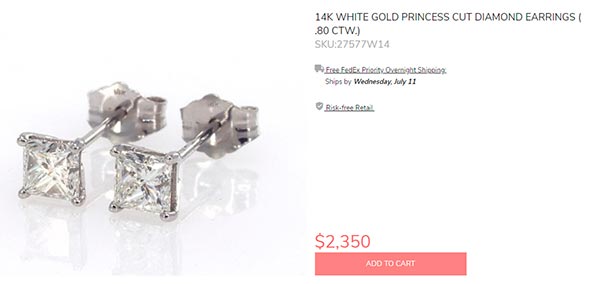
My overall recommended retailer for the 0.75 carat range is James Allen. James Allen is one of the largest jewelry retailers on the web, with access to a huge range of diamonds.
One of the best things they offer is great images of every stone, including a rotatable 3D view, so you can see exactly what you’re getting which makes them a great choice for fancy shaped stones, as well as your standard fare.
1 Carat Weight Diamond Stud Earrings:
Cost
The average cost for round brilliant 1 carat diamond stud earrings is approximately $2,000, although this will depend on the shape and quality of the diamonds used.
Examples
This gorgeous pair of 1 carat diamond stud earrings is round brilliant cut, and basket set in 14kt white gold. Available for just over $2,000, click here to find out more about these Diamond Stud Earrings in 14kt White Gold from my recommended retailer Blue Nile.
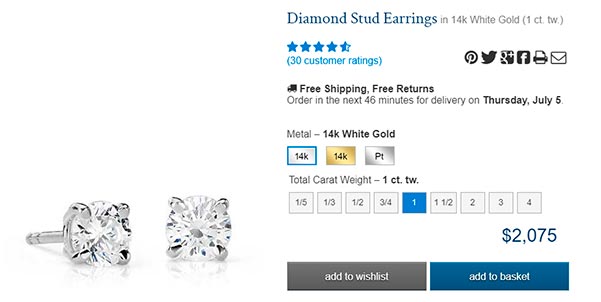
This pair of 1 carat diamond stud earrings is princess cut, and basket set in 14kt yellow gold. Available for under $2,000, click here to find out more about these Princess Diamond Stud Earrings in Yellow 14kt Gold from my recommended retailer Blue Nile.

Best place to buy diamond stud earrings

Blue Nile is the largest and most well known online jewelry retailer. They have the industry-leading largest available exclusive online inventory. Their high quality images are catching up to James Allens’ and their prices are amazing.

James Allen is the leader in online diamond sales. Their imaging technology is at the point where it’s almost the same as inspecting a diamond with a jeweler’s loupe. Their customer experience is best in class, and they have recently upgraded their non-engagement jewelry inventory as well.
